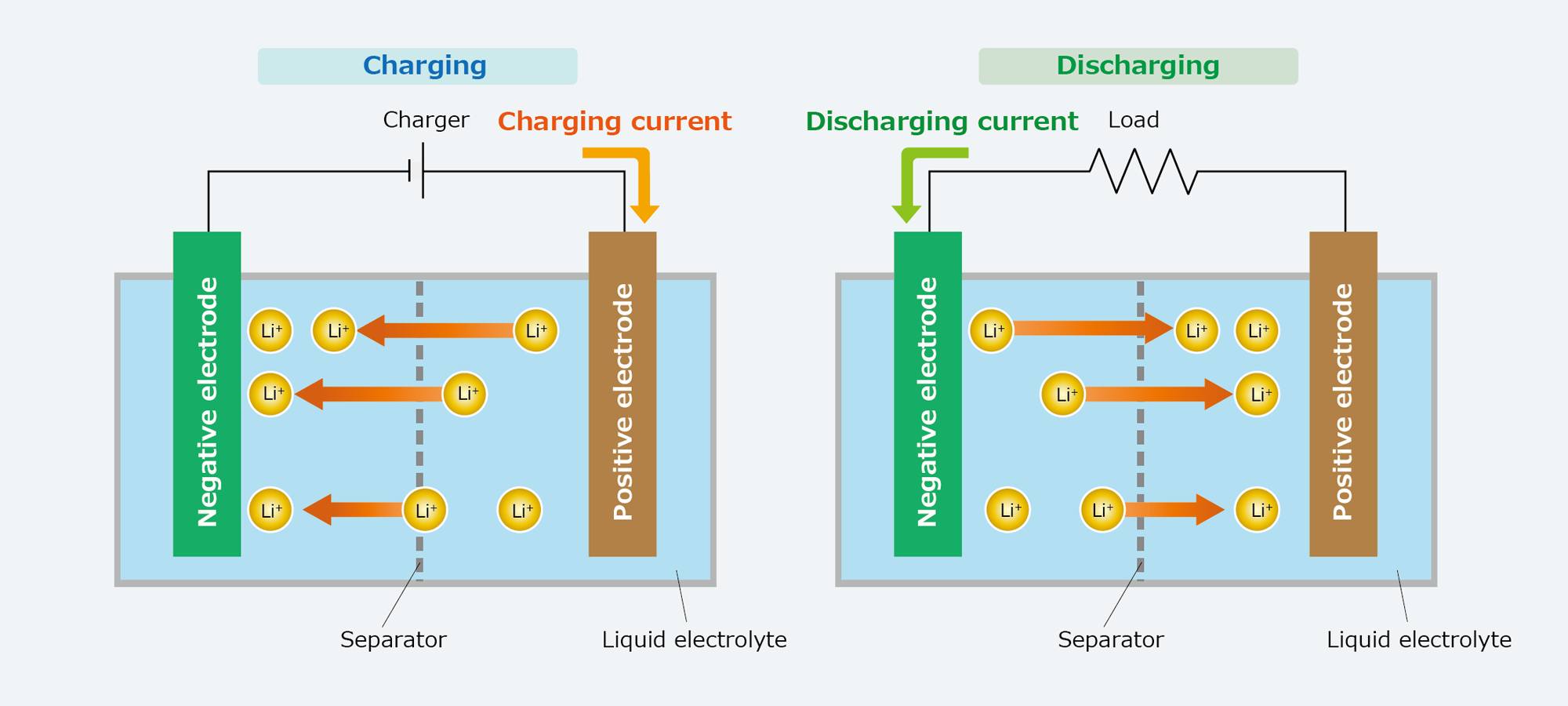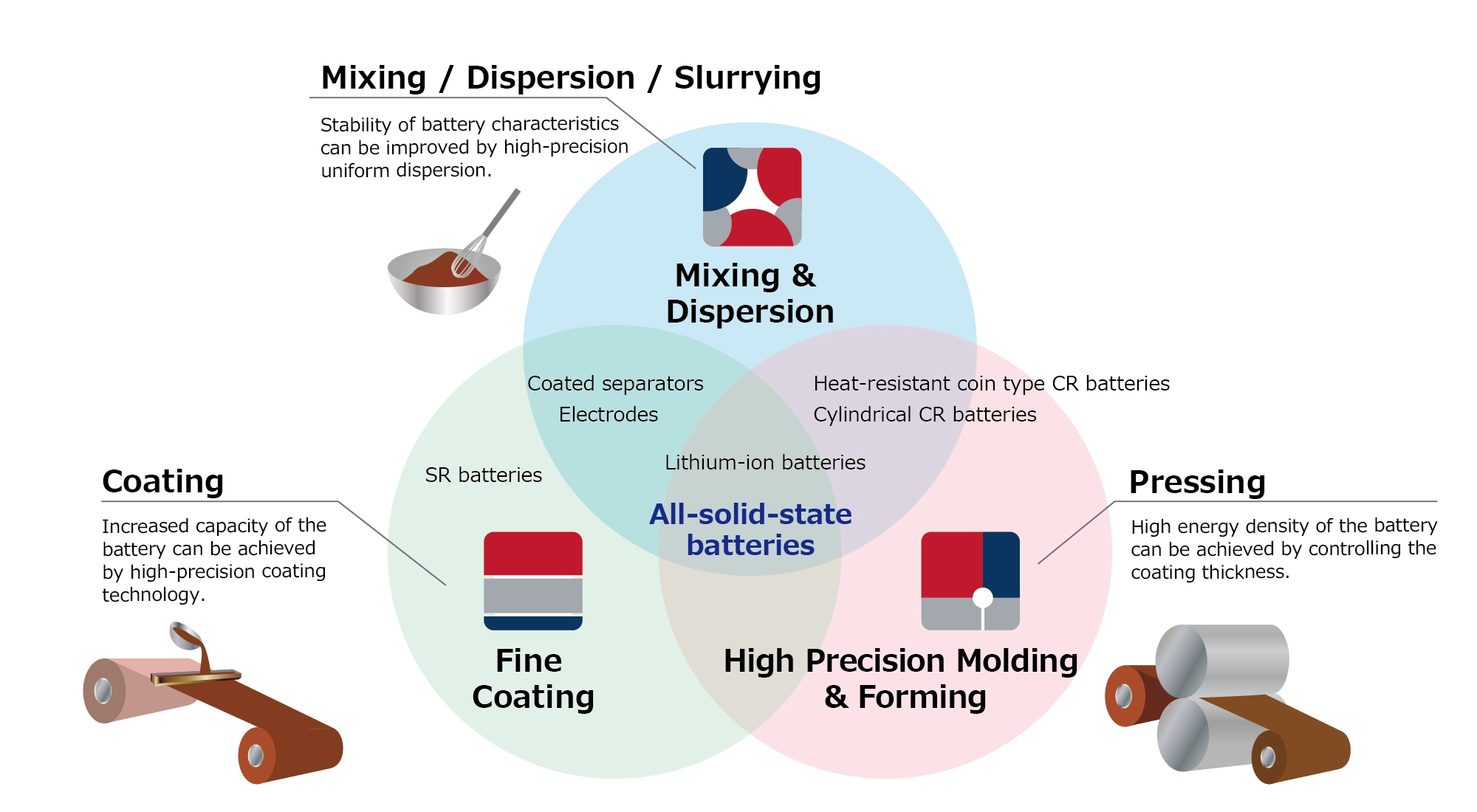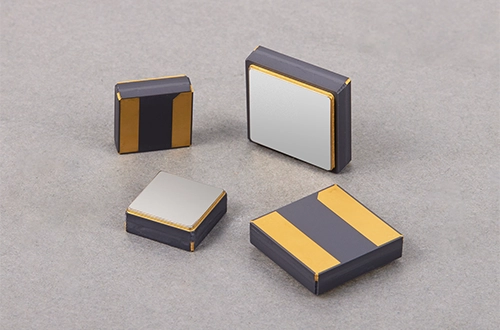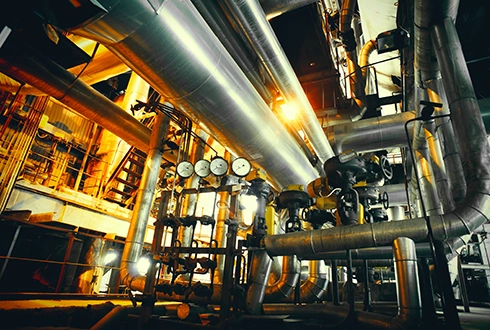What are all-solid-state batteries?
| Explanatory article: All-solid-state batteries | ||
| Creating a new market with unprecedented next-generation power solutions |
Generally, all-solid-state batteries do not use liquid electrolyte. Thus, they are considered to be safe, reliable, and long-life batteries. Among the next-generation of all-solid-state batteries, Maxell is committed to the development and mass production of the sulfide-based all-solid-state lithium-ion batteries, that have the special features of high output and high capacity∗1, utilizing the battery design, development, and production technologies, which are the foundation of our business.
The followings are detailed explanations of the all-solid-state batteries awaiting practical application.
Rechargeable batteries that do not use liquid electrolyte
The basis of chemical batteries was formed by means of trial and error to obtain high voltage batteries by combining two types of metals, since the invention of the voltaic cell around 1800.
After batteries were introduced to Japan in the 1800s, batteries were assembled by Japanese owned companies. The batteries at that time had a problem of leakage of liquid electrolyte. "Dry-cell batteries" solved this problem, which were developed around the world. In Japan, a unique structure for dry-cell battery was invented, which uses carbon rods. It led to today's dry-cell batteries structure, which attracted attention from all over the world.
This is why Japan has become one of the world’s leading countries in battery development and manufacturing.

Even though various types of chemical batteries have been created, from the past to the present, why are all-solid-state batteries needed?
A chemical battery converts its chemical energy into electrical energy, and it is mainly composed of three elements: a positive electrode, a negative electrode, and an electrolyte. Among these chemical batteries, single-use batteries are classified as "primary batteries" and batteries that can be recharged and used repeatedly are classified as "rechargeable batteries." Normally, both types of batteries adopt liquid as electrolytes.
- For basic knowledge about the classification and principles of bateries, please refer to the technical article "The Origins of Technological Innovation - History and Basic Principles of Batteries".
Various liquid electrolytes are used with these types of batteries, from aqueous ectrolytes with less risk of ignition to electrolytes with a flammable organic solvent etc.
"Lithium-ion batteries" are the most familiar rechargeable batteries.
The main components of lithium-ion batteries are positive and negative electrodes, a separator separating them, and liquid electrolyte. A metal compound containing lithium is used for the positive electrode, and a graphite, which can store lithium ions is used for the negative electrode. The energy is stored (charged) and emitted (discharged) by lithium ions and electrons move back and forth between the positive and negative electrodes.

Mechanism of charging and discharging of the lithium-ion battery
Lithium-ion batteries can be miniaturized and generally, they can discharge an electrical current at a wide range of temperatures from -20 to +60 deg. C. The batteries do not greatly deteriorate even after repeated charge and discharge cycles, and also carry large current at high voltage, so that they can drive mobile devices and electric vehicles repeatedly for a long time in various environments.
However, such a convenient lithium-ion batteries also have a week point. As highly flammable organic solvents are contained in the electrolyte, they may lead to a dangerous situation such as ignition, smoke generation, or heat generation, depending on the use conditions under which the batteries are used.
If solid electrolytes are used in place of liquid electrolyte, that may solve this issue. The earliest commercially available battery using a solid electrolyte is the lithium-iodine battery that is used for cardiac pacemakers. It is possible to ensure high safety and long-term reliability by using solid electrolyte. It can be said that the battery is suitable for implantation in the body because of its safety; however, application has been restricted. Thus, regarding rechargeable lithium ion batteries, it is also possible to compose a battery with excellent safety by an all-solid-state battery using a solid electrolyte. Using solid electrolytes for lithium-ion batteries can improve their performance issues, such as battery life and heat resistance of 100 deg. C.

Typical construction of conventional lithium-ion battery and all-solid-state battery
Comparison of Various Batteries
There are several types of all-solid-state batteries. The currently commercialized all-solid-state batteries mainly use sulfide-based and oxide-based solid electrolytes. Each of these solid electrolytes has its own unique advantages and disadvantages, and battery manufacturers develop their products by leveraging their strengths.
| Item | Maxell all-solid-state batteries | Sulfide-based solid-state batteries | Oxide-based solid-state batteries | Typical lithium-ion battries |
|---|---|---|---|---|
| Ion Conductivity | ★★★ | ★★★ | ★ | ★★ |
| Chemical Stability | ★★ | ★ | ★★★ | ★★ |
| Mass Production Feasibility | ★★★ | ★★ | ★ | ★★ |
Comparison of Various Batteries
In sulfide-based all-solid-state batteries, various efforts are being made to improve chemical stability and water resistance, while in oxide-based all-solid-state batteries, improvements in ionic conductivity are being pursued. Recently, chloride-based solid electrolytes have gained attention due to their improved ion conductivity.
Advantages of Maxell’s all-solid-state batteries
Unlike oxide-based all-solid-state batteries, the sulfide-based all-solid-state batteries developed by Maxell do not require high-temperature sintering in the manufacturing process, making them highly mass producible. These batteries feature high output and high capacity∗1. Moreover, Maxell's all-solid-state batteries utilize an argyrodite-type solid electrolyte, which stands out for its exceptional balance of mass production, stability, ion conductivity, and moldability among sulfide-based solid electrolytes. This technology effectively suppresses the increase in resistance associated with repeated charge-discharge cycles and long-term storage, resulting in improved discharge capacity under high load conditions after long-term cycles or storage compared to conventional batteries with liquid electrolyte.
Maxell's sulfide-based all-solid-state batteries, with their superior ion conductivity, are expected to be applicable in a wide range of applications, including power sources requiring high output, such as sensors and wireless communications.

Maxell has been developing and manufacturing lithium-ion batteries and micro batteries for many years based on our battery design, development, and manufacturing business, which continues from the time of founding.
Maxell is developing all-solid-state batteries with high performance∗2 and high reliability∗3 by combining the analog core technologies of "Mixing & Dispersion (mixing)", "Fine Coating (coating)", and "High Precision Molding & Forming (forming)" cultivated through our business and technology developed in collaboration with other companies, and moreover adding newly developed process technologies.
Maxell is mass-producing ceramic-packaged all-solid-state batteries by utilizing factories, equipment, manufacturing technologies, and know-how of micro batteries and lithium-ion batteries within Japan.
- For more detailed technical information, please enter the customer information and refer to "All-solid-state Battery Documents Download".

Applications where Maxell’s all-solid-state battery is the best choice
Maxell’s all-solid-state batteries are the small-sized next-generation batteries that combine three features: safety∗4, battery characteristics (life, capacity, output), and heat resistance.
We believe that these batteries contribute to solving social issues such as declining birthrate and aging population, decreasing working population, and environmental conservation, and also provide additional value to the device equipped with the battery, where conventional lithium-ion batteries are unsuitable and primary batteries have been used, or for applications with safety issues depending on the usage condition if lithium-ion batteries are used.
Because of these features such as small size, high output, safety, long life∗5, and high heat resistance∗6, all-solid-state batteries are suitable for factory automation (FA), medical devices that require sterilization, wearable devices, etc.
For factory automation (FA), they can be repeatedly used even in an environment where high temperatures are expected, such as rotating joint parts of robots, and the frequency of maintenance such as battery replacement can be reduced.
With a medical device that requires sterilization, normally the device and the battery could not be sterilized at the same time in an autoclave due to the heat. Simultaneous sterilization is enabled by using an all-solid-state battery with excellent heat resistance, making it possible to maintain the sanitary conditions of medical devices, which had previously been a concern. With the declining birthrate and aging population, wearable sensors for biological monitoring are becoming more widespread, so safety is required for batteries that are in close contact with the body.
- For application details, please refer to "Solving issues, adoption, and collaboration case studies".

Moreover, aspects essential for responding to future prospects are popularization of vehicles’ ADASs (advanced driving assistance systems) and EVs. As autonomous driving progresses, the number of sensors in the vehicle increases. Small emergency backup batteries that can drive the sensors even if the main power supply fails due to a sudden accident, etc. are expected to be mounted in many places such as the car body, doors, and seats.
These batteries are also useful for sensing tire conditions. Primary batteries have been used due to charging issues; however, rechargeable batteries with higher capacity that can be repeatedly used in harsh environments are required due to the increase in sensing information.
Maxell develops technologies day-by-day by making products for these applications that combine the energy harvesting technology that convert natural energy to electric power with the all-solid-state battery.
- High output and high capacity: These characteristics are equivalent to the rated capacity and the maximum discharge current of Maxell’s conventional coin type lithium-ion rechargeable battery (927 size).
- High performance: Indicating high heat resistance, long life, and high safety.
- High reliability: Based on the result of comparison with Maxell’s conventional coin type lithium-ion rechargeable batteries (927 size) in an over-discharge storage test.
- Safety: No ignition or smoke generation is seen in various safety tests such as heating at 350 deg. C, nail penetration, and external short circuit.
- Long life: The Maxell conventional coin-type lithium-ion battery (927 size) can maintain 90% capacity for 10 days, while the all-solid-state battery can maintain 90% capacity for 100 days, based on accelerated testing at 60 deg. C.
- High heat resistance: It is possible to discharge up to 125 deg. C. The heat resistance is high compared to that of general lithium-ion batteries.




